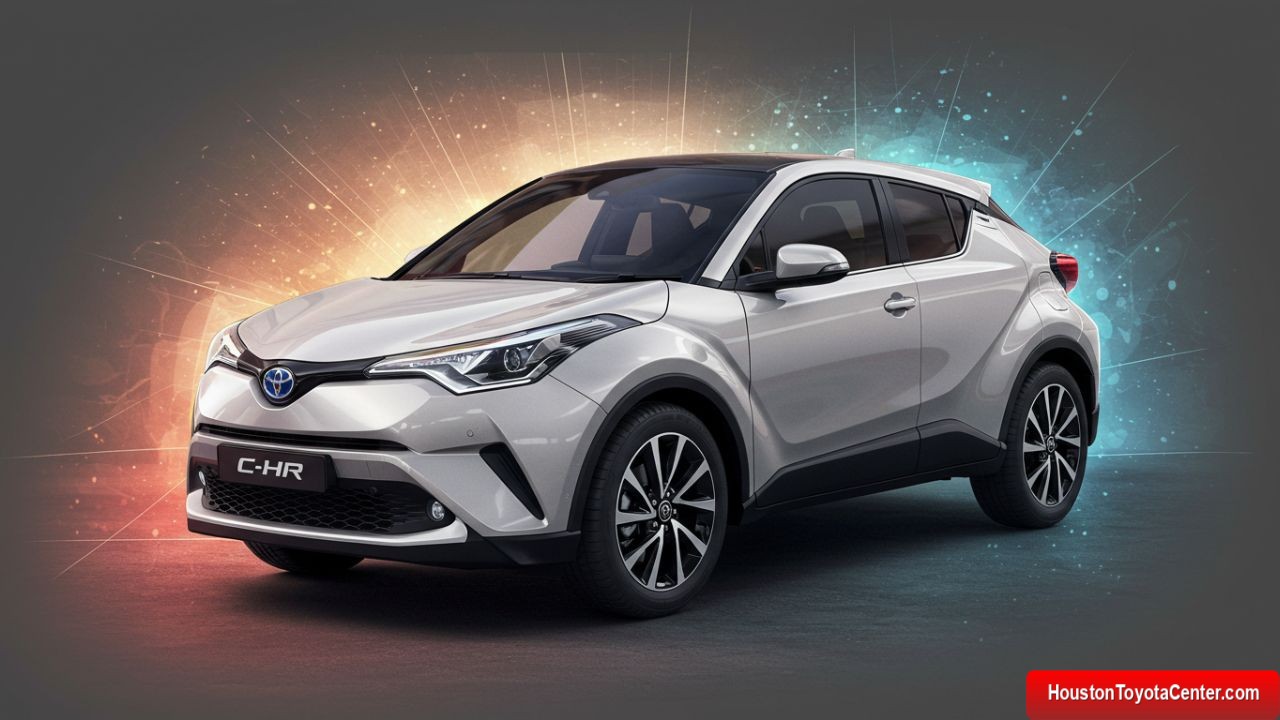In the ever-evolving world of automotive design, few cars stand out as boldly as the Toyota C-HR. This compact crossover, first introduced in 2016, has stirred conversations and divided opinions across the automotive world. Its audacious styling, futuristic shape, and striking design elements have drawn admiration from some, while others have dismissed it as over-the-top and impractical. In this article, we’ll explore the factors behind the Toyota C-HR’s bold styling, its impact on the automotive market, and delve into the debate surrounding its design. Is the Toyota C-HR a triumph of innovation or a design misstep?
Introduction to the Toyota C-HR
The Toyota C-HR (Coupe High-Rider) is a compact crossover SUV produced by Toyota. Its unusual, angular design sets it apart from the sea of more conservatively styled competitors in the market. The vehicle was initially designed with a focus on creating an urban, sporty, and highly stylish compact SUV, catering to younger buyers looking for something different from the norm.
The C-HR’s design represents Toyota’s efforts to break away from its traditional approach to car styling, embracing bold lines, dynamic shapes, and a unique silhouette. From its sloping roofline to its sharp rear end and aggressive front fascia, the C-HR flaunts an identity that dares to be different. However, not everyone is convinced by its aesthetic choices, and its polarizing nature has led to a debate: is the Toyota C-HR’s bold styling a masterstroke, or is it simply too much?
The Origins of the Toyota C-HR
To understand why the C-HR looks the way it does, it’s important to examine its origins. Toyota’s goal with the C-HR was to create a compact crossover that would appeal to a younger, more fashion-conscious audience. The design team aimed for a vehicle that was not only practical but also a visual statement. The C-HR was based on the Toyota New Global Architecture (TNGA) platform, which also underpins other popular models such as the Toyota Prius and the Toyota Corolla.
FREE: Quickly identify and understand problems with your vehicle 🚘
CLICK HEREThe C-HR’s development was influenced by Toyota’s growing desire to capture the attention of younger drivers and urban dwellers. This desire for a stylish, fun-to-drive SUV that didn’t compromise on practicality is what ultimately led to the car’s unique design. The C-HR was originally introduced as a concept vehicle at the 2014 Paris Motor Show, and its production version quickly made its way to the market two years later.
A Look at the Design Elements of the Toyota C-HR
The Toyota C-HR’s design is arguably one of the most polarizing aspects of the vehicle. The aggressive styling and sharp lines have caused some to praise its forward-thinking look, while others criticize it for being unnecessarily flashy and even impractical. Let’s take a closer look at the design elements that make the Toyota C-HR stand out in the crowded crossover segment.
The Front Fascia: Bold and Aggressive
The front end of the C-HR is undeniably bold, with its oversized hexagonal grille and angular headlights. The lower bumper features exaggerated air intakes, creating a dynamic look that suggests performance. The grille design is flanked by sharp, sculpted lines that add to the C-HR’s aggressive stance.
One of the most divisive features of the front end is the “diamond” shaped grille that gives the C-HR its unique face. While some find this feature daring and distinct, others view it as overly busy and out of place in an otherwise compact SUV segment. The Toyota emblem sits proudly in the center of the grille, completing the bold aesthetic.
The Side Profile: Chiseled and Dynamic
The side profile of the Toyota C-HR is one of the most distinctive aspects of its design. The roofline slopes downward dramatically, creating a coupe-like silhouette that blends crossover versatility with a sporty appearance. The angular creases along the sides, combined with the sculpted wheel arches, give the C-HR a muscular stance that stands out from more traditional crossover designs.
One of the most noticeable design features along the side is the sharply defined shoulder line that runs the length of the car, giving it a sense of movement even when stationary. The rear door handles are cleverly integrated into the window frame, hidden just below the rear window, adding to the C-HR’s sleek, modern design.
The large alloy wheels and narrow, high-set windows further accentuate the car’s sporty, high-riding appearance, while the sharply sloping roofline emphasizes its coupe-like proportions. However, the compact dimensions and the high beltline of the C-HR may not appeal to those who prefer the more traditional, squared-off shapes of most compact crossovers.
The Rear End: Polarizing and Sculptural
At the rear, the Toyota C-HR continues to turn heads. The tailgate has a distinctive sculptural design with sharp angles and curves that make the car look more like a sports car than a traditional SUV. The rear bumper features contrasting black trim and integrated exhaust outlets, reinforcing the vehicle’s dynamic character.
The rear lights of the C-HR are another talking point. They feature a bold, light strip design that stretches across the width of the vehicle, giving the rear end a futuristic look. The slim, wide taillights create a unique visual signature, but some argue that they are too complex and detract from the simplicity of the overall design.
One feature that has garnered both praise and criticism is the rear spoiler that juts out from the roof. This element reinforces the C-HR’s sporty image, but some feel that it detracts from the vehicle’s otherwise sleek and sophisticated rear end.
The Interior: Functional Yet Stylish
Inside, the Toyota C-HR offers a design that complements its exterior styling. The interior features a futuristic dashboard with a large touchscreen interface and high-tech instrument displays. The angular lines from the exterior are mirrored inside the cabin, creating a cohesive design language.
The materials used in the cabin are generally high-quality, with soft-touch surfaces and a mix of textures that give the interior a premium feel. However, the bold design choices extend to the interior as well, with the central console featuring unique sculptural elements that some may find a bit over-the-top.
While the interior design may not be as radical as the exterior, it’s still clear that Toyota has put effort into creating a space that feels modern and youthful. However, the design may not be to everyone’s taste, especially those who prefer a more traditional, straightforward interior layout.
The Debate: Love It or Hate It?
The Toyota C-HR’s bold styling has sparked intense debate among automotive enthusiasts and consumers alike. Some love its edgy design and believe it represents a much-needed departure from the cookie-cutter designs of many compact SUVs. They argue that the C-HR’s unconventional look is a breath of fresh air in a segment where many vehicles seem to blend into one another.
On the other hand, critics of the C-HR’s design feel that the bold styling goes too far, making the vehicle look over-designed and impractical. The sharp angles and aggressive features, while eye-catching, can make the C-HR appear busy and cluttered, leading some to question whether the design sacrifices functionality for the sake of aesthetics. The rear visibility, for example, is limited due to the sloping roofline and narrow rear window, which may deter those who prioritize practicality.
Furthermore, some consumers have expressed concerns about the C-HR’s usability. The coupe-like roofline, while giving the car a sportier appearance, can restrict rear seat headroom and cargo space, making it less practical than other compact crossovers with more traditional designs.
Despite the controversy, the Toyota C-HR has garnered a loyal following. Many appreciate the vehicle’s striking looks and its willingness to break free from conventional design norms. The C-HR has proven to be a success in markets where buyers are looking for something different—particularly in urban environments where style often takes precedence over practicality.
The Impact on the Market
The Toyota C-HR has certainly made an impact on the market, and its design has inspired a new generation of compact crossovers that embrace more unconventional styling. While the C-HR was one of the first to break away from traditional crossover design in such a bold manner, other manufacturers have followed suit with vehicles like the Nissan Juke, Hyundai Kona, and Kia Soul, all of which feature similarly daring designs.
The C-HR has shown that there is a market for vehicles that prioritize bold design and personality over traditional, conservative styling. Toyota’s gamble on the C-HR has paid off, with the vehicle becoming one of the brand’s best-selling models in many regions, particularly in Europe and North America.
Conclusion: A Bold Success or a Design Flop?
When it comes to the Toyota C-HR’s bold styling, there is no middle ground. Some people love it, seeing it as a fresh and exciting departure from the mundane designs of most compact crossovers. Others hate it, finding the sharp angles, aggressive lines, and overall complexity of the design to be unnecessary and off-putting.
In the end, the Toyota C-HR represents a new direction for automotive design—one that embraces risk and challenges the status quo. Whether you love it or hate it, there’s no denying that the C-HR has left a lasting impression on the automotive landscape, and its bold styling has helped it carve out a niche in the competitive crossover market.
While the C-HR may not be for everyone, it serves as a reminder that, in the world of car design, being bold and daring can sometimes be the key to standing out in a crowded field. For Toyota, the C-HR has been a statement piece, and whether you’re a fan of its design or not, it’s clear that this compact crossover has shaken up the traditional notion of what a compact SUV should look like.


Leave a Reply